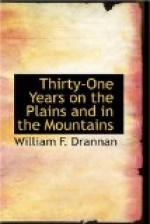That was all I wanted to know, and I did not ask him any more questions, nor did I tell him of our trouble with the nine Sioux. I told him we wanted to hire four young men from his tribe to go to the fort with us. He said: “All right, I’ll see tomorrow.”
Our idea in wanting the young Kiowas along, after finding they were on good terms with the Sioux, was that we knew when we were in company with the Kiowas the Sioux would not give us any trouble.
The day following, in the afternoon, Blackbird came to us and told us that there were four young men who wanted to go with us and asked how long we would be gone. We told him we might be gone one moon, perhaps not so long. He wanted to know what Indian country we would pass through. I told him none but the Comanches, for they were terribly afraid of Navajoes. We assured him that we would not pass through their country.
On the day appointed for the sale of our goods, the robes came in by the hundreds. I never saw anything equal it.
We conducted our sale something like an auction. I would hold up a string of beads and show them to the crowd; an Indian would step forward and offer a robe for two strings of beads. Another would offer a robe for one string. This was our idea for appointing a certain day for trading with them, for the more Indians present the better prices we were able to get for our goods.
We went there this time with about the amount of goods we had always taken before to trade for a train load of robes, and we sold our entire stock the first day. We could have traded ten times that amount. Moreover, we got about one-half more than we could pack at one trip.
We knew before we started in to sell that there was a greater number of robes in the village than at any time we had visited it before, as we had been pretty well over the village, and I had never seen the like of robes and dry buffalo meat before, nor have I since. Every wick-i-up was hanging full. The Indians said it had been the best season for buffalo they had seen for years.
I never saw people more busy than the squaws were. All were dressing buffalo hides, and every family had from three to one dozen robes, and this was the best day’s sale we ever had, as it seemed that the Indians were crazy for the rings and beads.
I just mention these facts to show the reader how the people took advantage of those Indians, for at that time they did not know the value of money and had no use for it except as ornaments. They would pay a big price for a half dollar, but every one they got hold of they would hammer out flat, punch two holes through it and put it on a string; then the chief or some of his family would wear them on their backs or fasten them to their hair and let them hang down their backs. I have seen strings of flattened out half dollars two feet long worn by the chief or some member of his family.
When we went to pack up we could only get two-thirds of our robes on the animals so we left the remainder in charge of Blackbird, and he agreed to look after them until we returned. I told him if he would take good care of them I would bring him a big butcher knife when I came back.




